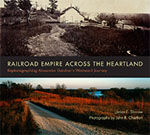Railroad Empire across the Heartland
James E. Sherow and John R. Charlton, photographer
book reviews:
· general fiction
· chick lit/romance
· sci-fi/fantasy
· graphic novels
· nonfiction
· audio books
· author interviews
· children's books @
curledupkids.com
· DVD reviews @
curledupdvd.com
newsletter
win books
buy online
links
home
for authors
& publishers
for reviewers

 |
Railroad Empire across the Heartland: Rephotographing Alexander Gardner's Westward Journey James E. Sherow and John R. Charlton, photographer University of New Mexico Press Paperback 224 pages September 2014 |
|
Alexander Gardner had “an artistic genius that Walt Whitman and Abraham Lincoln…highly esteemed.” Born in Scotland, he was a keen participant in the Abolitionist movement and worked with the legendary Mathew Brady during the Civil War. In the post-war era, he was hired by the Union Pacific Railway Company to capture photographically the emergence of what was for a time the most important industry in America, an industry that heralded, touted, and enabled the settlement of the West.
James Sherow, environmental and cultural historian at the University of Kansas, has compiled the complementary photographs with a text describing the histories of each scene. The result is a large glossy tome that will fascinate anyone with an interest in Americana, railroads, and the great Western migration. There is, of course, the expected contrast of black-and-white versus color photos, the subtraction of certain buildings from the modern version of particular scenes, and the addition, in modern pictures, of rather annoying electrical wires and towers intruding on what was once a pristine frontier landscape. For example, the main thoroughfare in Topeka, Kansas in 1867—a grassy expanse crisscrossed by the ruts of wagon wheels—became in 1994 a four-lane avenue with a few two-story buildings, possibly remnants from the olden days, among the many taller structures. What has not changed in character or much in terrain are the lonely grass-covered plains, visually punctuated in one photograph, by flowering Spanish Bayonet, “which seems to suggest,” Sherow comments, “that the Great Plains were not always desert.” By such artistic devices, the railroads sought to attract Easterners to settle moisture-starved and almost uninhabitable regions of the heartland. Pictures of long stretches of track and stolid iron bridges were similarly strategic to creating confidence in the journey; photos of burgeoning towns would bring to the imagination secure settlements served by active rail commerce. Sherow puts us in each frame: “Gardner is facing north,” he tells us, to photograph “Santa Fe trade wagons ready and loaded up…” While today, he notes, US Highway 56 “follows the old Santa Fe Trail diagonally across the state.” One interesting manner of comparison between the scenery old and new is Charlton’s juxtaposition of his modern photos side-by-side with ones that Gardner produced for the very popular stereopticon. One such photo captures a sharp curve on Amphitheatre Road, Leavenworth, Kansas: a narrow dirt trail through semi-desert scenery on the left morphs, on the right, into a stretch of asphalt highway thickly lined with trees. Railroad Empire across the Heartland Originally published on Curled Up With A Good Book at www.curledup.com. © Barbara Bamberger Scott, 2015 |
|
|
|
 Click here to learn more about this month's sponsor! |
|
| fiction · sf/f · comic books · nonfiction · audio newsletter · free book contest · buy books online review index · links · · authors & publishers reviewers |
|
| site by ELBO Computing Resources, Inc. | |
 Gardner’s photographic technique involved the laborious use of glass plates, silver iodide, and varnish. In the 1990s, another photographer--John R Charlton--revived enthusiasm for Gardner’s work by as closely as possible producing modern versions of the same scenery the earlier artist had depicted. Charlton’s work spanned the era of the darkroom and silver film into the development of digital photography.
Gardner’s photographic technique involved the laborious use of glass plates, silver iodide, and varnish. In the 1990s, another photographer--John R Charlton--revived enthusiasm for Gardner’s work by as closely as possible producing modern versions of the same scenery the earlier artist had depicted. Charlton’s work spanned the era of the darkroom and silver film into the development of digital photography.